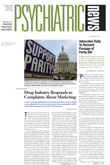Psychiatry training will have to change if residents are going to graduate equipped to deal with the shifting demands of the health care system and the knowledge explosion about brain disorders and how to treat them, educators insist (see story on
page 18). One intractable problem that defies easy solution, however, is how to make a research career appealing to future psychiatrists.
A critical strategy is to take “a longitudinal view of mentorship and skill building,” said Charles Reynolds, M.D., a professor of psychiatry and neuroscience at the University of Pittsburgh and associate dean of its medical school. This can’t happen in one training module or class.
The components to building a career in research are a complex blend of intellectual orientation, disciplined thinking, technical and managerial skills, and a commitment to the idea that “scholarly advances improve patient care,” Reynolds said at APA’s annual meeting in May.
Unfortunately, he noted, this mixture is becoming increasing difficult to find. The number of physicians who identify themselves as principal investigators or say that research is their major professional activity declined from 4.2 percent in 1984 to 1.8 percent in 1999. There has also been a 50 percent decline in the number of physicians applying for research fellowships at the National Institutes of Health/National Institute of Mental Health.
Reynolds attributed the steep decline to the amount of debt young physicians face and the time required to prepare for a research career.
He described a research-mentoring program instituted by Pittsburgh’s Western Psychiatric Institute and Clinic that has established a research-career “developmental pathway” that begins at the undergraduate level and continues through medical school, residency, and fellowship and into junior and then senior faculty positions.
To make sure that there is adequate support for these promising researchers, the university set up the Junior Faculty Scholar program, which provides partial support for up to eight junior faculty members, Reynolds said. This backing comes in the form of salary support, research seed money, and statistical help on research projects.
“We’ve learned these students want a very focused didactic course. The students are active problem solvers; they don’t like to just sit in a classroom,” he pointed out. “What we haven’t learned to do yet,” he added, is find a way to foster greater faculty involvement with and mentoring of these researchers to be. Doing so “needs to be a value of the department chair, and if it is, it should then trickle down to the faculty.”
